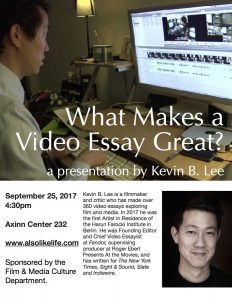Dec 4 & 6: In-class viewing of final video essays
December 15:
All revised videos and written commentaries due by noon!
Dec 4 & 6: In-class viewing of final video essays
December 15:
All revised videos and written commentaries due by noon!
November 13 – Videographic Responses
November 15 – More Videographic Responses
November 20 – Guest Filmmaker: Jen Proctor on Video Art, Feminism & Videographic Criticism
November 6 – Behind the Scenes of a Video Essay
November 8 – Copyright and Fair Use
October 25 – Share Abstract Trailers
October 30 – Share Remaining Abstract Trailers
November 1 – Workshop Response Videos
October 16 – Share Algorithmic Videos
October 18 – How to Make a Video Essay?
October 9 – Share Multiscreen Videos
October 11 – Assignment #5 Workshop
October 2 – Share Epigraph Videos
October 4 – Assignment #4 Workshop
September 25 – Share voiceover videos
Attend Kevin Lee presentation, 4:30pm in Axinn 232

September 27 – Assignment #3 workshop
September 18 – Share PechaKucha videos
September 20 – Assignment #2 workshop
Reminder: Kevin B. Lee will be visiting on Sept 25, with a public presentation at 4:30pm in Axinn 232.
September 12 – Introduction in-class
September 14 – Assignment #1 Workshop
Each week, students should find a video essay published somewhere online and write a commentary on it. Commentaries should be posted before class on Wednesday morning. The commentary should strive to answer two basic questions: what did I learn from this video about the subject matter? and what did I learn from this video about the videographic form? Commentaries should be at least 250 words, but should be as long as necessary to explore the ideas.
© 2024 Videographic Film & Media Studies Fall 2017
Theme by Anders Noren — Up ↑
Sample Video Commentary: What Is Neo-Realism?
This 2013 video by the acclaimed video essayist kogonada, originally published in Sight & Sound magazine, is deceptively straightforward. On the one hand, it seems like an explanatory video that provides a comparison between two versions of the same film – we could probably read the transcript of the voiceover and understand the essay’s key argument about the differences between Hollywood cinema and neorealism.
But kogonada’s tonal mastery adds additional dimensions to the video that transcend the ideas expressed by the words alone. First off, the use of the split screen allows us to experience the distinctions between the two versions, not just have them described via prose. The video lingers on the extended shots, recreating the effect of duration that kogonada suggests is an essential component of neorealism – just as filmgoers would see Terminal Station‘s takes endure beyond normal expectations, we experience them surpassing the Hollywood norms, feeling the effect of the neorealist aesthetic.
Additionally, kogonada frames the entire piece in a suggestive and poetic tone. Instead of using the academic framework of an argument, thesis statement, or reference to other critics, he posits the entire video as an experiment requiring a time machine. Is this science fiction? His voiceover tone certainly suggests that something is a bit off from conventional academic discourse. This opening frame locates the entire video within the realm of speculative fiction, even though its content is fully rooted in history and critical analysis. Thus when he arrives at his conclusion, drawing the link between neorealism and the essence of cinema, it feels less like a conclusive argument by a persuasive critic, but more of a hypothesis offered by a somewhat mad scientist (or artist). Thus the videographic form embraces a poetic mode that encourages a degree of uncertainty and abstraction, much more than we would expect or allow for in a written essay.